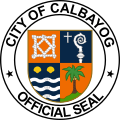Calbayog | |
|---|---|
| City of Calbayog | |
Skyline of Calbayog Bangon Bugtong Falls Port of Calbayog Calbayog City Convention Center Calbayog City Hall | |
Nicknames:
| |
 Map of Samar with Calbayog highlighted | |
 Interactive map of Calbayog | |
Location within the Philippines | |
| Coordinates: 12°04′N124°36′E / 12.07°N 124.6°E | |
| Country | Philippines |
| Region | Eastern Visayas |
| Province | Samar |
| District | 1st district |
| Cityhood | October 16, 1948 |
| Barangays | 157 (see Barangays) |
| Government | |
| • Type | Sangguniang Panlungsod |
| • Mayor | Raymund C. Uy |
| • Vice Mayor | Rex M. Daguman |
| • Representative | Stephen James Tan |
| • City Council | List |
| • Electorate | 151,946 voters (2025) |
| Area | |
• Total | 880.74 km2 (340.06 sq mi) |
| Elevation | 63 m (207 ft) |
| Highest elevation | 851 m (2,792 ft) |
| Lowest elevation | 0 m (0 ft) |
| Population (2024 census) [3] | |
• Total | 187,848 |
| • Density | 213.28/km2 (552.40/sq mi) |
| • Households | 43,030 |
| Demonym | Calbayognon |
| Economy | |
| • Income class | 1st city income class |
| • Poverty incidence | 25.93 |
| • Revenue | ₱ 2,229 million (2022) |
| • Assets | ₱ 5,720 million (2022) |
| • Expenditure | ₱ 1,319 million (2022) |
| • Liabilities | ₱ 810 million (2022) |
| Service provider | |
| • Electricity | Samar 1 Electric Cooperative (SAMELCO 1) |
| Time zone | UTC+8 (PST) |
| ZIP code | 6710 |
| PSGC | |
| IDD : area code | +63 (0)55 |
| Native languages | Waray Tagalog |
| Website | www |
Calbayog, officially the City of Calbayog (Waray : Siyudad san Calbayog; Filipino : Lungsod ng Calbayog), is a component city in the province of Samar, Philippines. According to the 2020 census, it has a population of 186,960 people. [5]
Contents
- History
- Unraveling of Revolutionary Society, Katipunan
- After Spain transferred power to USA
- 2008: Death of a Judge
- 2011 Onwards: Political Deaths
- Upgrade of city status
- Geography
- Climate
- Barangays
- Demographics
- Infrastructure
- Utilities
- Education
- Colleges and Universities
- Vocational School
- High Schools and K-12
- Media
- AM Stations
- FM Stations
- TV Stations
- Cable and Satellite
- Notable personalities
- See also
- References
- External links
It lies along the coastal region of the province stretching about 60 miles (97 km) from the northern tip of the island and 180 miles (290 km) from southern boundaries.
It is the sixth largest city in terms of land and water areas in the Philippines. It is the nineteenth city of the Philippines. In 2020, Calbayog has 37,807 households with a population of 186,960 people, making up 24.7% of the total population of the province of Samar which is the most populous. [6] Calbayog is one of the commercial trade centers in Eastern Visayas. Calbayog is subdivided into three major districts: Calbayog, Tinambacan and Oquendo.














